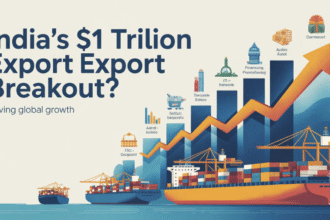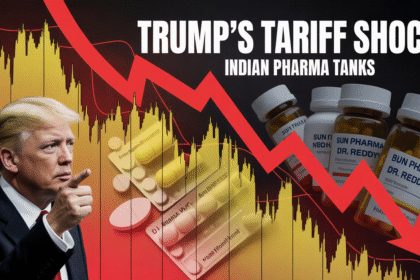After closing FY24-25 with its highest-ever total exports of $825 billion, India’s export momentum is showing no signs of fatigue. In fact, if projections hold, FY26 may be the breakout year where India steps into the coveted $1 trillion export club, fundamentally reshaping its role in global trade.
The optimism isn’t unfounded. Behind these numbers is a mix of robust services exports, recovering merchandise trade, aggressive policy reforms, and structural shifts in global supply chains that are steadily favoring India.
Services: India’s Silent Powerhouse
– India’s services exports have emerged as the engine room of this growth story. Sectors like IT, consulting, fintech, healthcare outsourcing, and professional services are driving record demand. For FY26, services exports alone are projected to touch $465–475 billion, reflecting a robust ~20% YoY growth.
– Backing this optimism is India’s Services PMI for May 2025, which clocked in at 58.8—one of the highest globally—signaling strong international demand for India’s services offerings.
Merchandise Exports Recover and Diversify
– On the merchandise side, India has navigated through several global disruptions — including the Red Sea crisis, shipping delays, and geopolitical tensions — to stabilize its export flows. For FY26, merchandise exports are forecasted to grow 12% YoY, reaching $525–535 billion.
– Key sectors fueling this rise include electronics, pharmaceuticals, engineering goods, defense, and chemicals — sectors that are benefiting from both global demand and domestic capacity expansion.
Policy Tailwinds Provide the Thrust
– The government’s aggressive trade diplomacy is also paying dividends. Multiple Free Trade Agreements (FTAs) are being fast-tracked with nations like UAE, Australia, and the UK, opening up new export corridors.
– At the same time, reforms spearheaded by DPIIT and the Traders’ Welfare Board in e-commerce, logistics, and MSME compliance frameworks are simplifying trade procedures, reducing costs, and unlocking a broader exporter base, particularly among MSMEs.
Supply Chains Shift Towards India
The global China+1 strategy continues to redirect manufacturing and sourcing towards India. As global companies recalibrate their supply chains, India is emerging as a preferred hub for electronics assembly, auto components, specialty chemicals, and textiles. This long-term structural shift is adding stability and depth to India’s export engine.
The $1 Trillion Question: Can India Deliver?
According to the Federation of Indian Export Organisations (FIEO), if the current growth trajectory continues, India could clock an over 21% growth in exports this fiscal, putting the $1 trillion mark within reach. Achieving this would not only be a record but would also mark the biggest annual export jump in India’s history.
Risks That Still Lurk
Despite the optimism, some headwinds remain:
– Fragile demand from key markets like EU and US
– Continued geopolitical uncertainties in Middle East, Russia-Ukraine, Red Sea
– Currency volatility that can impact export pricing competitiveness
Bottom Line
India’s export basket is no longer narrow. Diversification, policy support, global realignment, and services dominance are all coming together. FY26 may very well be the year India breaks through the $1 trillion ceiling — not just as a milestone but as a major repositioning in the global trade arena.







